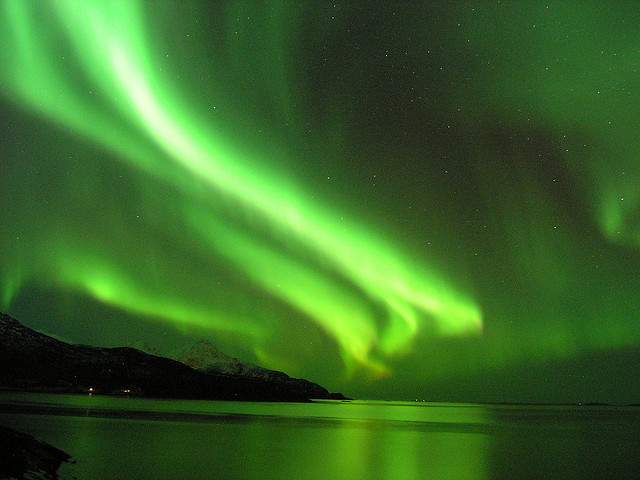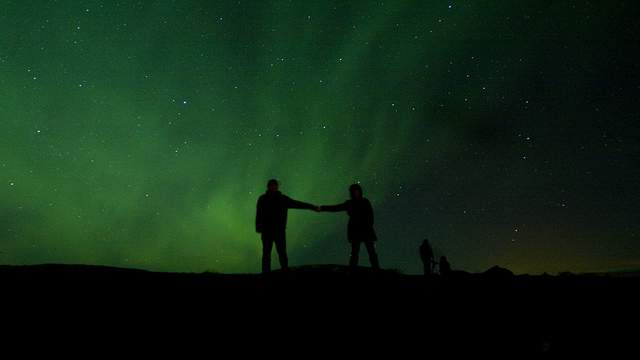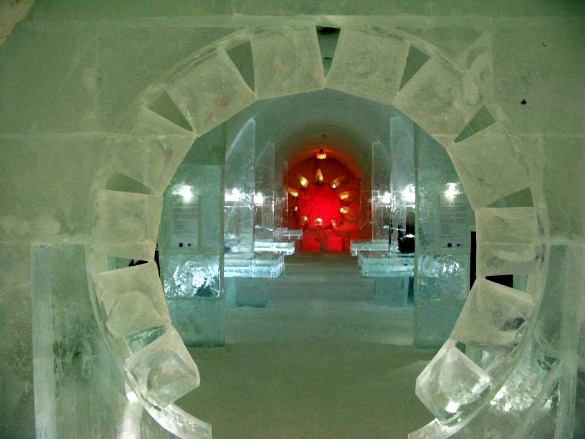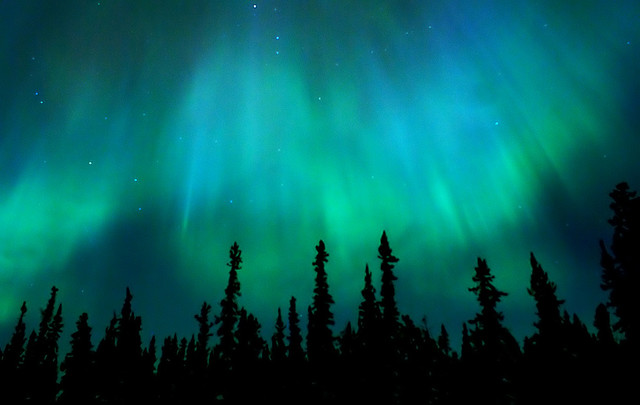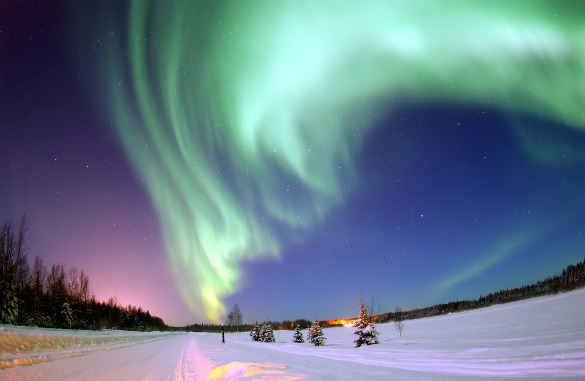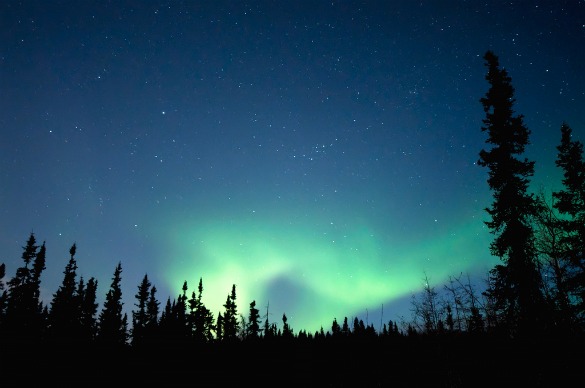The Northern Lights, also known as Aurora Borealis, occur in northern latitudes. The name originates from Aurora, the Roman goddess of Dawn, and Boreas, the Greek name for the north wind. From far away, the Northern Lights illuminate the northern horizon with a greenish glow or at times, a faint red that makes it seem as if the sun were coming up from a strange direction.
When energetically charged particles collide with atoms in the high altitude atmosphere, a natural light display occurs in the sky. To be exact, the charged particles originate in the magnetosphere and solar wind and then the Earth’s magnetic field directs them into the atmosphere and specifically, into the high altitude atmosphere, also known as thermosphere. The light display that occurs is called an aurora. While a diffuse aurora might not even be visible to the human eye, a discrete aurora has strongly defined features that can be bright enough to allow you to read a newspaper at nighttime.
Scientific details aside, the light show is just so cool to view that many people plan their trips to northern destinations specifically in the hopes of seeing these strange dancing streaks of colored light. If seeing the Northern Lights is on your bucket list, here are eight locations to consider.
Tromsø, Norway
The city of Tromsø is also known as the Gateway to the Artic. At a latitude of nearly 70 degrees north, Tromsø provides a rich cultural and intellectual life that has also given it the name of “Paris of the North.” Visitors are charmed not only by the city historical center and patriotic residents, but also by natural wonders, including the Northern Lights.
The best opportunities for viewing the Northern Lights in Tromsø are after 10 pm from mid-October to mid-March, when it is dark. Ideal viewing locations are located outside the city (so that the city lights don’t interfere). There are numerous tour operators and even private guides that offer excursions. Frequently, these will include a lavvo (traditional Saami tent), an open fire, hot drinks and snacks to keep you entertained as you wait for them to appear. For some extra fun, you can also combine your visit with an activity such as dog sledding, sleigh riding, snowshoeing or cross-country skiing.
Another option is to stay overnight in the outskirts, such as in the village of Svensby or the Lyngen Alps. Last but not least, a popular excursion is that of the Coastal Express Steamer (operated by Hurtigruten), a ship that travels through the darkness and provides ideal viewing opportunities.
>> Find a hostel in Tromsø or read our Norway travel guide
The Ice Hotel, Jukkasjärvi, Sweden
The Ice Hotel is an attraction in itself, but it is also ideal for viewing the Northern Lights. As the name states, it is a hotel made entirely of frozen water from the Torne River. It never stands still; that is, the hotel transforms from frozen solid in the winter back to a free flowing river in the summer and includes the artwork of numerous national and international artists. In fact, it prides itself on being an “exclusive art exhibition.” Guests sleep on beds of snow and ice, covered in reindeer skins.
The first winter guests are greeted at the beginning of December, when you can start viewing the building processes that are completed by the end of the year. This is also the time when your chances of seeing the Northern Lights are most favorable. During these weeks, the weather conditions are at their coldest, and the white snow becomes the reflection of a heavenly light show, including the Northern Lights that appear as swirling rivers of greenish-blue light. If the sky is clear, you can see them move and dance unpredictably, their brightness fading in and out.
>> Book flights to Sweden or read our Sweden travel guide
Vatnajökull, Iceland
Vatnajökull, meaning “Glacier of lakes” in English, is the largest glacier in Iceland and covers more than 8% of the entire country. It provides a unique backdrop for viewing the Northern Lights, which swirl against snow-capped peaks.
Given that the visit to a glacier should be done with adequate safety precautions, it is best to book a tour. There are countless tour operators that combine visits to the glacier with Northern Lights viewings. Vatnajokull.is, for example, offers three, four and five day tours in winter, all of which include Northern Lights viewing. Optional activities include a boat tour, ATV safari on the black sands, a visit to Jökulsárlón (the glacier lagoon), a tour of Skaftafell National Park and an ice-climbing excursion.
>> Find flights to Iceland and read more about seeing the Northern Lights in Iceland
Kemi, Finland
Situated in the Bothnian Bay, Kemi is a town in the region of Lapland. In Lapland as a whole, the Northern Lights can be seen around 200 nights a year on average. At the latitude of Kemi, in turn, it averages to about 100 nights per year. The best time to catch them in action is between 8 to 11 p.m. during the months of September to October and February to March.
In Finnish, the Northern Lights are called Revontulet, meaning fox fires. This name originates from a time-old tale in which a fox was believed to move its bushy tail on the snowy fields, this way throwing sparks into the air.
If you would like to combine your stay in Kemi with a unique accommodation experience, consider the Kemi Snow Castle. Here, you can live the life of an Eskimo, reveling in an igloo that is rebuilt every year starting in December. In addition, the hotel also boasts a SnowRestaurant as well as a SnowChapel. Just in case you wanted to see the Northern Lights and get married right afterwards.
>> Book flights to Finland or read our Finland travel guide
Tuktoyaktuk, Northwest Territories, Canada
Tuktoyaktuk is an Inuvialuit hamlet situated in the Inuvik region that is part of the Northwest Territories in Canada. For ease of pronunciation, it is often referred to merely as “Tuk.” The hamlet is located north of the Arctic Circle, on the shore of the Arctic Ocean. With a population of around 870 people and extremely cold weather conditions, Tuktoyaktuk doesn’t offer a lot in terms of nightlife. But the viewing conditions for Northern Lights are ideal. The small size of the hamlet makes for clear skies, since there is no light pollution from a city to worry about.
Note that reaching Tuktoyaktuk by car is difficult; it can only be done during the winter, when the frozen Mackenzie River is plowed to form an ice road. Planes, in turn, leave the Inuvik airport relatively regularly, although they are also subject to weather conditions. You can also book a tour, such as with Arctic Range Adventure. On the “Ice Road Tuktoyaktuk” excursion, for example, 8 full days of viewing arctic landscapes (and the Northern Lights) are taken care of at $2,650.00/person. Touring season is from March to April.
>> Book a hostel in the Northwest Territories or read about the coldest places on every continent
Churchill, Manitoba, Canada
Churchill is a town located on the shore of Hudson Bay in Manitoba, Canada. Although it is known for being the “Polar Bear Capital of the World,” it is also a great spot to see the Northern Lights. In fact, scientists from all over the world have come here to study the phenomenon. Ideal times to go are from January through March, when the lights are at their most resplendent.
Due to the popularity of the viewings, specific plexiglass-covered Aurora Domes have been constructed. Here, you are sheltered from the cold and can watch the spectacular natural lightshow as if you were in the comfort of a movie theatre. During the summer, locals advise that you head out to Goose Creek, where you can set up a bonfire, grill some marshmallows and watch the spectacle over your head.
>> Find a Manitoba hostel or read our Manitoba travel guide
Bear Lake, Alaska
Bear Lake is located near the town of Seward and the Resurrection Bay. Access is granted from Bear Creek Road, which is connected to the Seward Highway. The above photo was taken by Joshua Strang, a U.S. Air Force airman, who was stationed nearby.
While you can find accommodation directly at Bear Lake (click here for options), some people choose to stay in Anchorage, a larger town nearby. You can see the Northern Lights both from Anchorage and from Bear Lake, but they are far more impressive at the latter because it is such a dark place. The best viewing opportunities are in late December to early February, since this is when the nights are longest and the skies are usually clear.
>> Find campgrounds in Alaska or read our Alaska travel guide
Fairbanks, Alaska
The largest city in the Interior region of Alaska, Fairbanks is situated in the central Tanana Valley, spanning the Chena River. Given Fairbanks’ high latitude location, it is ideal for viewing the Northern Lights. In fact, if you stay 3 nights in Fairbanks, you have an 80% chance of seeing them.
However, due to the city’s light pollution, the best viewing opportunities are on the outskirts. The Ester Dome, for example, provides a horizon to horizon view of the sky. In the Chatanika area, in turn, you can see a nice valley view. As you get closer to town, give the Gilmore Trail (looking west) a try, or head south Peger Road so that you can avoid the city lights. ExploreFairbanks.com provides a good round-up of tours you can combine your viewing experience with.
>> Find a hostel in Fairbanks or read about reasons to spend Christmas in Alaska
Can’t make it there?
Capturing the Northern Lights on photo and film has long fascinated mankind. For a particularly compelling rendering, check out “Pictures of Light,” a film by Swiss-Canadian filmmaker Peter Mettler. Mettler visited northern Manitoba during winter, where he filmed the aurora borealis.
Last but not least, keep in mind that the aurora borealis only refers to the Northern hemisphere. If you are located south, the auroroa australis, also known as Southern Lights, has very similar viewing features. You can see it from high latitudes in Antarctica, South America and Australia.
Read more about weather and strange phenomena around the world:
- 5 Places to Experience the Midnight Sun
- 11 Hottest Travel Destinations…Seriously
- Where to View Bioluminescent Organism
- 6 Natural Phenomena to See Before They Disappear
Photos: Guide Gunnar, bjaglin, Ben Husmann, Leo-setä, Aschaf, savillent, Studiolit, Joshua Strang, xyzpdqfoo.
